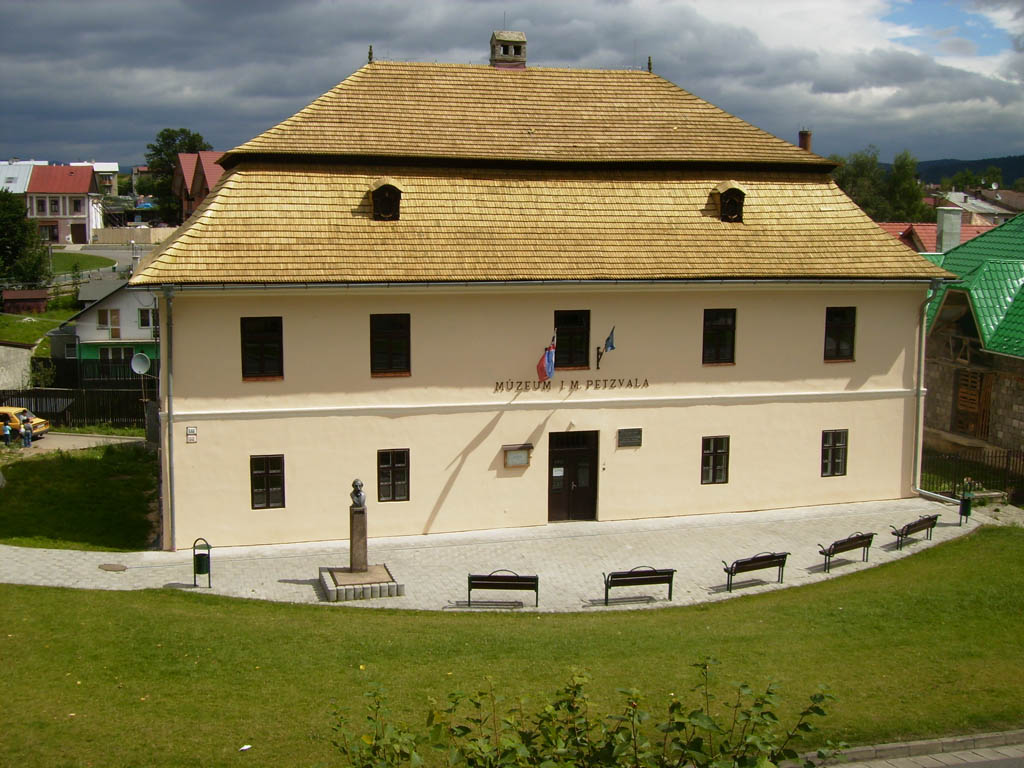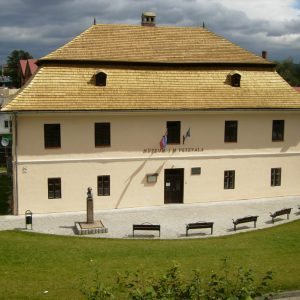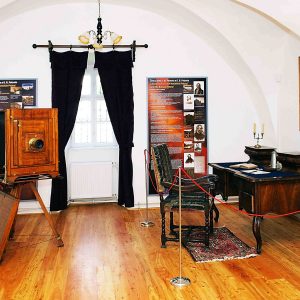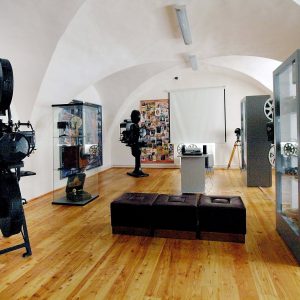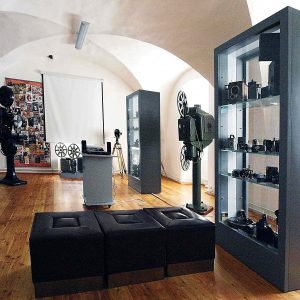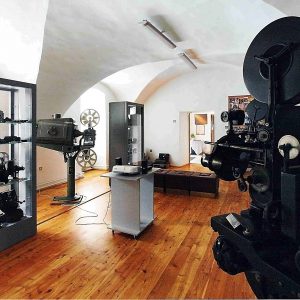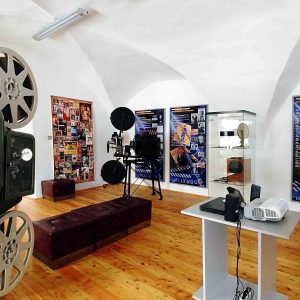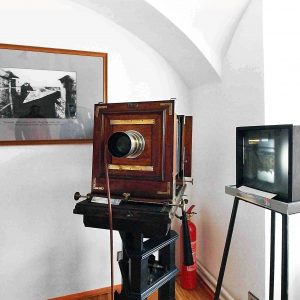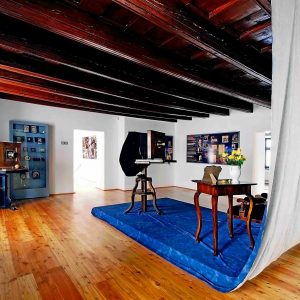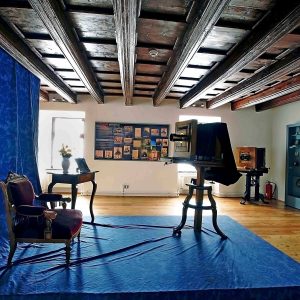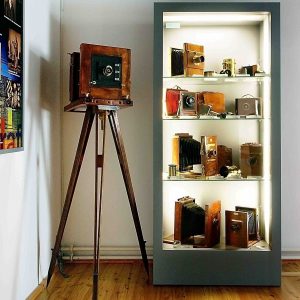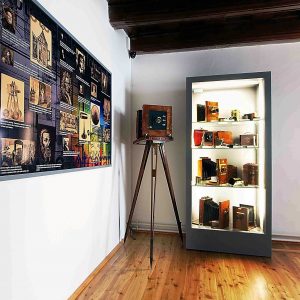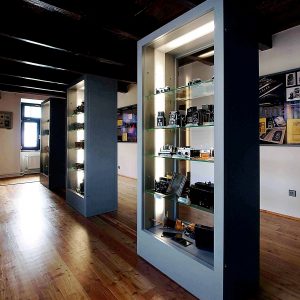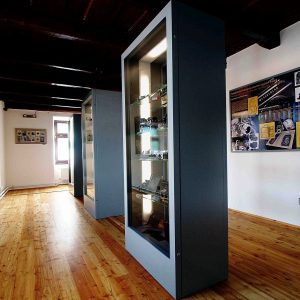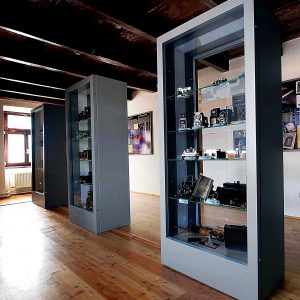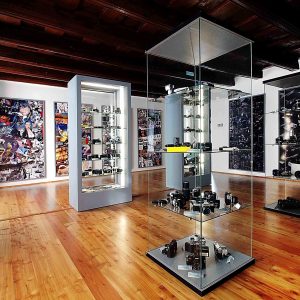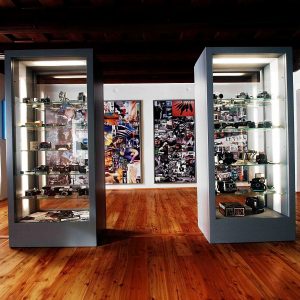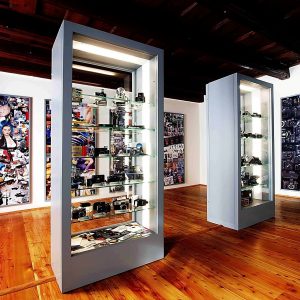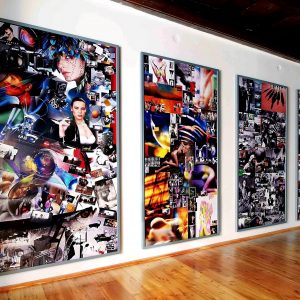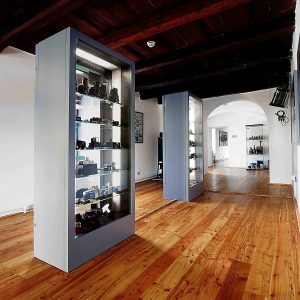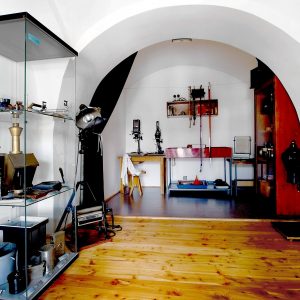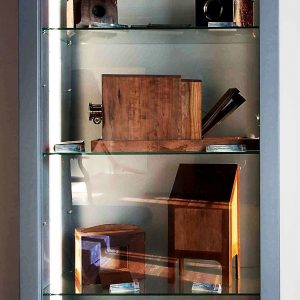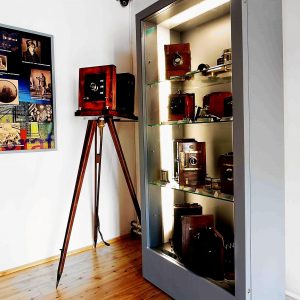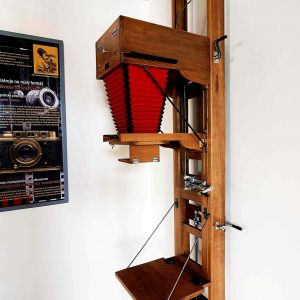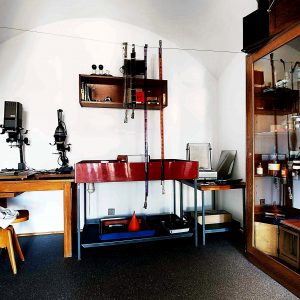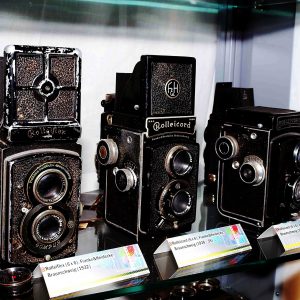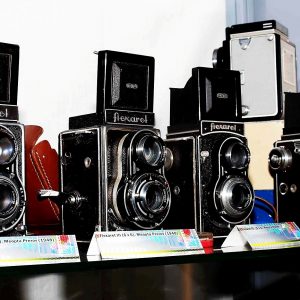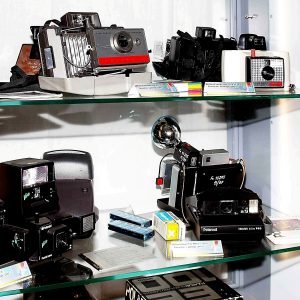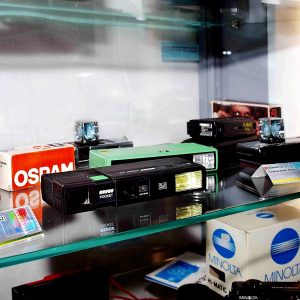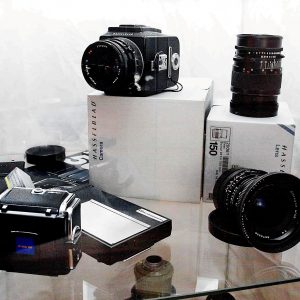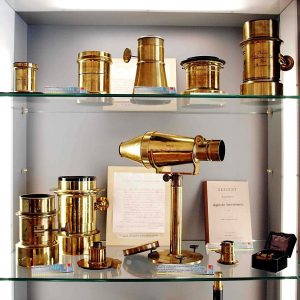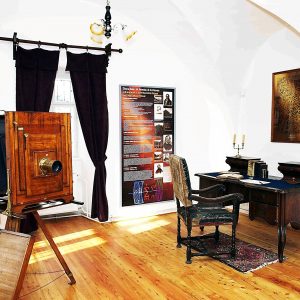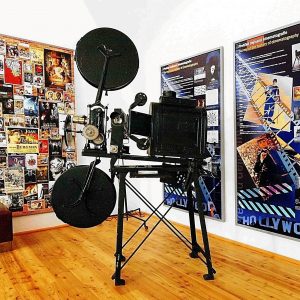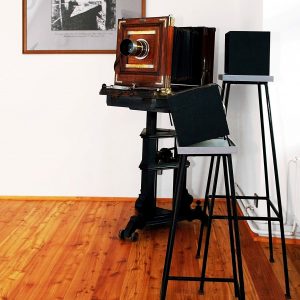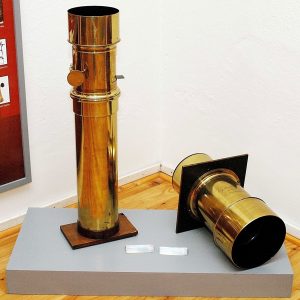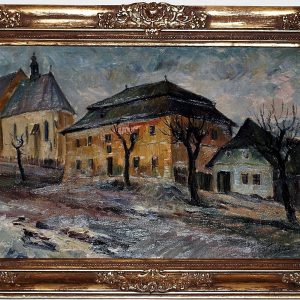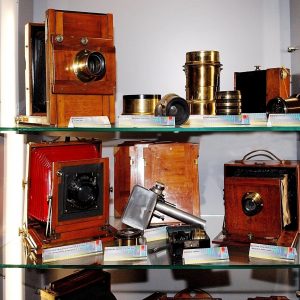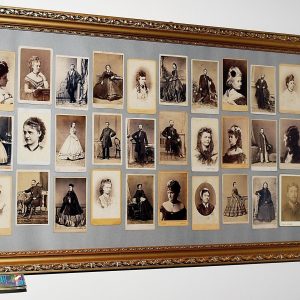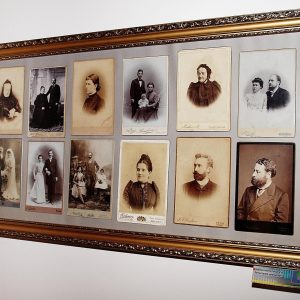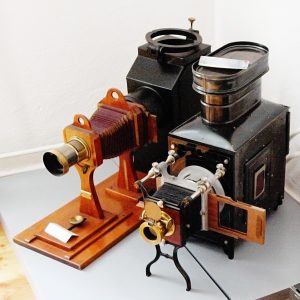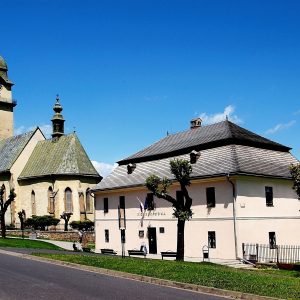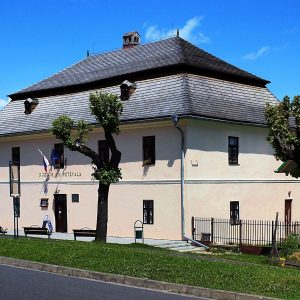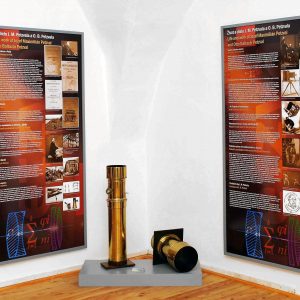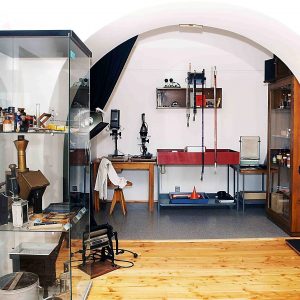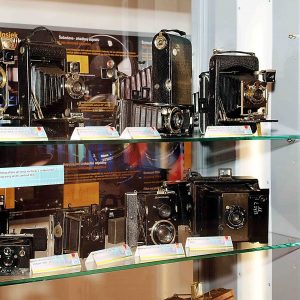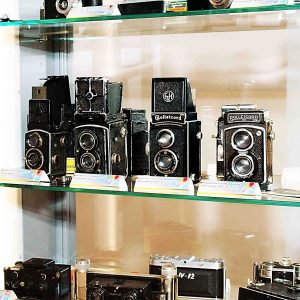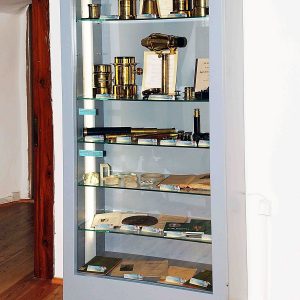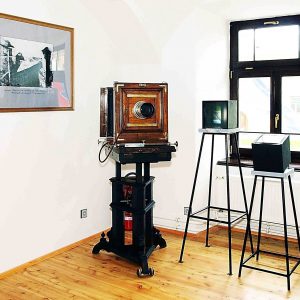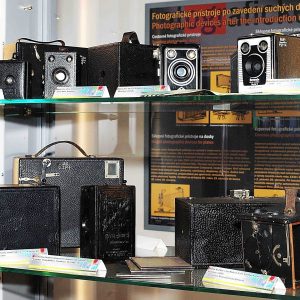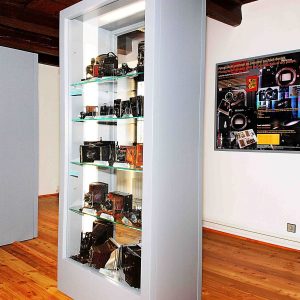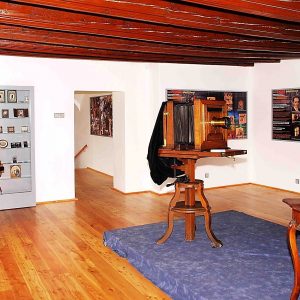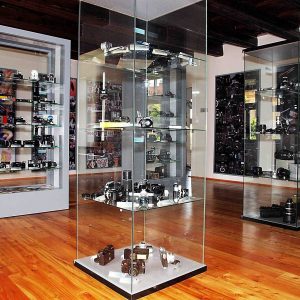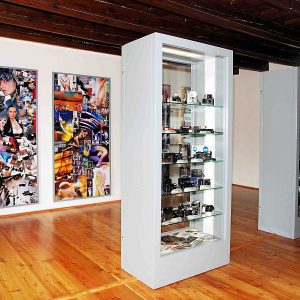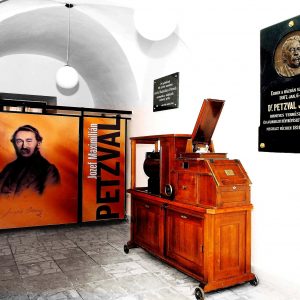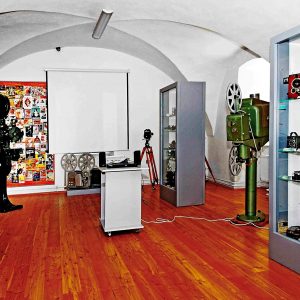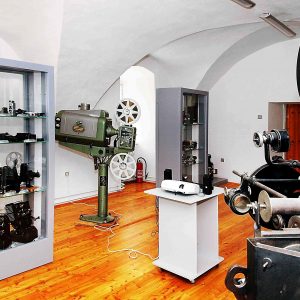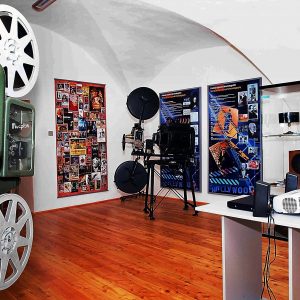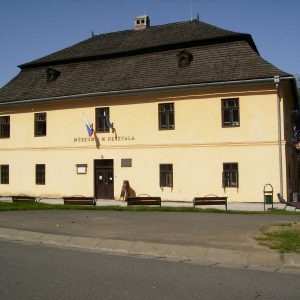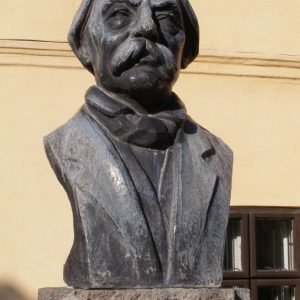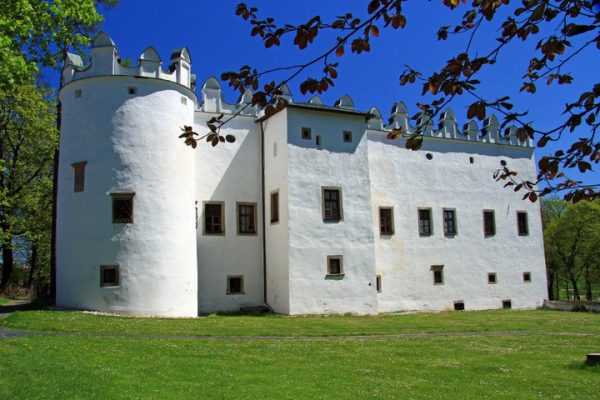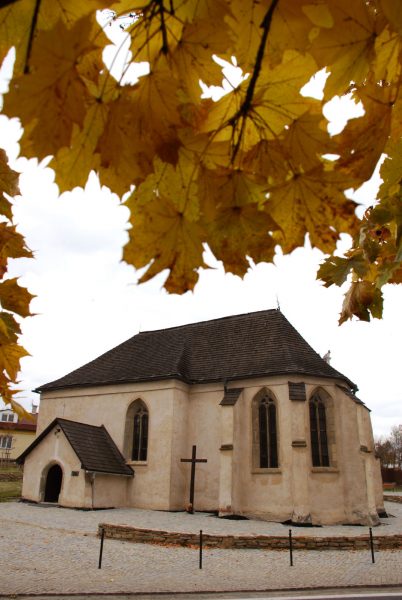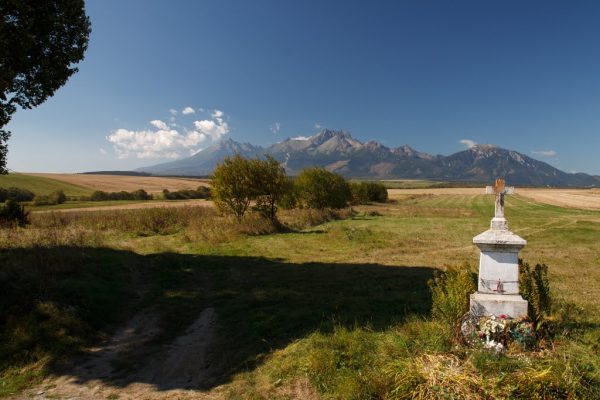5. Múzeum Jozefa Maximiliána Petzvala – Vitajte v múzeu J. M. Petzvala – prehliadka
![]() V roku 1699 bola zbúraná pôvodná drevená stavba a na jej mieste v tomto roku bola postavená prízemná murovaná stavba v neskororenesančnom slohu, čo dokumentujú na prízemí zachované hrebienkové klenby. V roku 1757 dostala barokizujúcu nadstavbu a vnútornú úpravu s plochými drevenými kazetovými stropmi z červeného smreka na prvom poschodí. Z tých istých čias neskorého baroka pochádza aj strecha manzardovského typu s vikiermi.
V roku 1699 bola zbúraná pôvodná drevená stavba a na jej mieste v tomto roku bola postavená prízemná murovaná stavba v neskororenesančnom slohu, čo dokumentujú na prízemí zachované hrebienkové klenby. V roku 1757 dostala barokizujúcu nadstavbu a vnútornú úpravu s plochými drevenými kazetovými stropmi z červeného smreka na prvom poschodí. Z tých istých čias neskorého baroka pochádza aj strecha manzardovského typu s vikiermi.
Budova slúžila ako nájomný kantorský a učiteľský byt. Na prízemí terajšieho múzea bol od septembra 1944 i štáb nemeckého generála Bäckera, ktorý riadil medziiným i protipartizánsku vojenskú akciu v Lendaku 27.10.1944. Po roku 1947 – 1960 budova slúžila ako nájomný bytový dom. Drevená strecha je po rekonštrukcii v roku 2009 obnovená. Múzeum je v správe Slovenského technického múzea v Košiciach. V rodnom dome J. M. Petzvala vzniklo v roku 1964 i zásluhou občanov mesta Spišská Belá múzeum. Vo vstupnej časti budovy nás víta portrét J. M. Petzvala v nadživotnej veľkosti. Po pravej strane sa nachádza veľký sálový epidiaskop od firmy Carl Zeiss z Jeny. Pamätná tabuľa z roku 1909 z čierneho mramoru pripomína, že v budove tejto bývalej školy sa 6. januára 1807 J. M. Petzval narodil. Otec Ján Krstiteľ Friedrich Pecivál v roku 1799, po úspešnej učiteľskej skúške, dostal miesto v Spišskej Belej. Bol aj organistom. V roku 1800 sa oženil s dcérou svojho predchodcu Zuzanou Kreutzmanovou, ktorá mala nemecký pôvod. Pod vplyvom nemeckého jazyka v našom regióne sa meno Pecivál zmenilo na Petzval. V rodine Jána Friedricha a Zuzany sa narodili traja synovia:
Volali ich aj traja králi Petzvali, pretože sa všetci narodili 06. 01. na sviatok Troch Kráľov. J. M. Petzval študoval na piaristickom gymnáziu v Podolínci. Musel tu ako jedenásťročný absolvovať reparát z matematiky. V r. 1818 sa rodina Petzvalovcov presťahovala do Levoče. Za pomoci otca sa bratia Jozef Maximilián (J.M.) a Otto Baltazár (O. B.) zdokonaľovali okrem slovenčiny aj v maďarskom, českom, nemeckom a francúzskom jazyku. Košická Kráľovská Akadémia bola miestom ďalšieho štúdia J. M. a O. B. Táto akadémia mala vysokoškolský charakter. J. M. Petzval si jeden rok po ukončení štúdia privyrábal ako vychovávateľ u grófa Almássyho v Ždani pri Košiciach. Institutum geometrico- hydrotechnicum v Pešti bolo založené v r. 1782 cisárom Jozefom II., pri filozofickej fakulte Budínskej univerzity. Bola to prvá škola v Európe, kde sa udeľoval titul inžiniera geodézie (zememeračstva), regulácie riek a stavby ciest. Na tomto inštitúte študoval J. M. Petzval v roku 1826 až 1828 a jeho brat O. B. Petzval v r. 1828 – 1830. J. M. Petzval v službách hlavného mesta Uhorska Pešti, ako mladý inžinier, riešil v r. 1830 závažný problém . Pešť zasiahli záplavy. Dal presekať hrádze, aby uvoľnil časti Dunaja na miestach, ktoré neboli veľmi ohrozené. Jeho rozhodnutie vychádzalo z presných geodetických meraní a výpočtov. Zachránil tak Pešť pred katastrofou a stal sa známym počas jednej noci. Popri náročnej inžinierskej praxi intenzívne pokračoval v samoštúdiu vyššej matematiky a fyziky. Po sedemročnej inžinierskej praxi od skončenia štúdia r. 1828 bol v r. 1835 menovaný za riadneho profesora vyššej matematiky. Veľkú popularitu mal aj ako vynikajúci šermiar, zápasník, atlét a priaznivec turistiky.
19.11. 1836 dostáva J. M. Petzval od cisára Ferdinanda menovací dekrét za vrchného profesora vyššej matematiky na univerzite vo Viedni, Bol hodnotený historikmi ako jeden z najvýznamnejších profesorov Viedenskej univerzity v 19. stor. na poli aplikovanej matematiky. R. 1840 J. M. Petzval dokončil návrhy dvoch objektívov. Portrétneho a krajinárskeho. Vlastnoručne vybrúsil aj šošovky na tieto objektívy, ale ich skonštruovanie si vyžadovalo znalosti z optiky. Zoznámil sa s viedenským optikom Friedrichom Voigtländerom a odovzdal mu výpočty aj vlastnoručne obrúsené šošovky, bez akejkoľvek zmluvy, ktorá by mu zaručila akýkoľvek podiel na zisku. A v tom istom r. 1840 začal Voigtländer vyrábať portrétne objektívy na základe Petzvalových výpočtov a predal ich vyše 10 000 kusov a J. M. Petzval okrem jednorazovej odmeny 2000 zlatých nedostal od Voigtländera nič. Počas 60 rokov zostal Petzvalov objektív neprekonaný a v prvých desaťročiach usmernil mohutný rozvoj fotografie.
Na zhotovenia krajinárskeho objektívu predložil J. M. Petzval výpočet viedenskej akadémii až v roku 1857. Urobil ho na pôvodnom princípe ako v roku 1840 a nazval ho dialytom. Petzval poučený trpkými skúsenosťami podpísal zmluvu s optikom Carlom Dietzlerom a dialyt si dal patentovať. Trh ovládol objektív Petzval – Dietzler, pretože trojnásobne prekonal Voigtländerov krajinársky objektív. Nový objektív sa osvedčil nielen vo fotoaparátoch, ale ja v ďalekohľadoch, neskôr v kinematografii a aj vo hvezdárskych ďalekohľadoch. Po príchode do Viedne si J. M. Petzval prenajal opustený kláštor na Kahlenbergu nad Viedňou. V kláštore sa venoval záhradníctvu, streľbe do terčov, jazde na koni, poľovníctvu, zápaseniu, šermu a turistike. Na Kahlenbergu mal vlastnú dielňu, v ktorej napríklad vyrobil originálny klavír a neskôr brúsil šošovky. Petzvalovo meno v spojení s fotografickým objektívom sa azda najdlhšie zachovalo v astrofotografii. Zdokonalil aj Galileiho tzv. holandský ďalekohľad tým, že zostavil objektív i okuláre troch navzájom achromatických šošoviek. Komory s objektívmi Petzvalovho typu sa uplatnili v astronómii a astrofyzike. Veľké duševné traumy zo sklamaní, ktoré zažil v konfliktoch s Voigtländerom a zničenie jeho celoživotného diela krádežou v jeho byte poznačili Petzvala v neskoršom veku. Poznamenalo to aj jeho spôsob života na Kahlenbergu. Vtedy vyslovil známu vetu: „Podmanil som svetlo, mám ho v hrsti, lebo na svete je ešte príliš veľa tmy.“ Ako 62-ročný sa oženil so svojou oveľa mladšou gazdinou Katarínou Schleglovou. Manželstvo však netrvalo dlho, pretože manželka po 4 rokoch zomrela. Na univerzite pôsobil do svojich 70-tich rokov. J. M. Petzval až do svojej smrti 17. septembra 1891 žil v ústraní. Ošetroval ho jeho sluha so svojou manželkou, ktorí sú aj podpísaní na jeho úmrtnom liste.
V Múzeu J. M. Petzvala je nainštalovaný aj historický mobiliár s doplnkami, ktoré majú znázorniť pracovňu J. M. Petzvala.
Ďalším zaujímavým exponátom je aj cestovný fotografický prístroj – prenosný – z roku 1870, ktorý už mal objektív vyrobený firmou Voigtländer na základe výpočtov J. M. Petzvala.
Schodiskom po pravej strane sa presunieme na poschodie do druhej tematickej časti expozície, ktorú tvoria 4 miestnosti a tie približujú historický vývoj fotoaparátov. Miestnosti sú chronologicky usporiadané od konca 18. storočia až po súčasnosť. Expozíciu múzea uzatvára tretí tematický celok: dejiny kinematografickej techniky a filmu. Táto časť expozície okrem základných informácií o dejinách kinematografie vo svete a na Slovensku reprezentuje v skratke vývojový rad snímacích prístrojov najrozmanitejších konštrukcií a techniky snímania, projekčné prístroje zo začiatku filmovej techniky, až po prístrojovú techniku nedávneho obdobia.
5. Welcome to the Museum of Joseph Petzval
![]() In 1699, the original wooden building that stood at this site was demolished and replaced by a one-story brick building in the late Renaissance style, which can be determined thanks to the comb-like vaulting on the ground floor. In 1557, the building was expanded by a Baroque structure and on the first floor, its interior was modified by larch wood ceilings. The mansard roof with dormers dates from the same period, the late Baroque.
In 1699, the original wooden building that stood at this site was demolished and replaced by a one-story brick building in the late Renaissance style, which can be determined thanks to the comb-like vaulting on the ground floor. In 1557, the building was expanded by a Baroque structure and on the first floor, its interior was modified by larch wood ceilings. The mansard roof with dormers dates from the same period, the late Baroque.
The building served as a rental house for parish clerks and teachers. On the ground floor of what is now the museum, the headquarters of the German general Bäcker were established in 1944. The general was in charge of the anti-partisan mission in Lendak on 27.10.1944. After 1947, and up until 1960, the building served as a rental apartment building. During a general renovation in 2009, the wood roof was renovated. The museum falls under the administration of the Slovak Technical Museum in Košice and was established in the house where J.M. Petzval was born in 1964, partly thanks to the residents of Spišská Belá. In the entrance hall, we are welcomed by a larger-than-life portrait of J. M. Petzval. On the right side, there is a large Epidiascope produced by the company Carl Zeiss of Jena. The black marble plate from 1909 commemorates the birth of J.M. Petzval in this former school building on January 6, 1807. After successfully completing his teacher certification, his father, Ján Krstiteľ Friedrich Pecivál, found work in Spišská Belá in 1797. He also played the organ. He married Zuzana Kreutzmanova, the daughter of his predecessor, in 1800. She was of German descent. Due to the German influence in our region, the name Pecivál came to be written and pronounced Petzval. Ján Friedrich and his wife Zuzana had three sons:
They were called the three Petzval kings, since they were all born on January 6, Three Kings‘ Day. J.M. Petzval went to school at the church gymnasium in Podolinec. Here he had to take a test in math at the age of 11. In 1818, the Petzval family moved to Levoča. With the help of their father, the brothers J.M. and O.B. perfected not only their Slovak but also their Hungarian, Czech, German and French language skills. The Royal Academy in Košice became the place of their further studies. It was similar to a faculty of higher learning. One year before completing his studies, J.M. Petzval worked as an instructor for count Almáss in Ždani near Košice. The geometric-hydrotechnical institute in Pest was established by Emperor Joseph II. in 1782, near the philosophical faculty of the Buda university. It was the first school in Europe to give out engineering degrees in geodetics/ land-surveying/ regulation of rivers and path construction. Here, J.M. Petzval studied from 1826 to 1828 and his brother O.B. Petzval from 1828 to 1830. Working for the capital of Hungary, Pest, J.M. Petzval was trying to solve a serious problem in 1830. Floods had reached Pest. He ordered that some sections of the levee be opened so that the Danube could flood into places that would not be threatened by the water. His decision was based on precise geodetic measurements and calculations. He saved Pest from a catastrophe and became famous overnight. While doing the demanding work of an engineer, he also devoted a lot of his attention to teaching himself higher math and physics. After his graduation in 1828, he worked as a engineer for seven years and then was named professor for math in 1835. He was well regarded as an excellent fencing master, athlete, and avid hiker, too.
On November 19, 1836, J. M. P. was decreed a professor of higher mathematics at the University of Vienna by Emperor Ferdinand. Historians consider him one of the most important professors of the Viennese university in the field of applied mathematics in the 19th century. In 1840, J.M. Petzval completed plans for two different objective lenses, a portrait and a landscape one. He even filed the glass for these lenses himself, but their manufacturing required optics skills. He met the Viennese optician Friedrich Voigtländer and gave him his calculations as well as the lenses that he had made. It did not occur to him to design a contract that would have guaranteed him a cut of the profit. That same year, Voigtländer started producing portrait lenses based on Petzval’s calculations and sold over 10 000 of them. J.M. Petzval did not receive any share of the profit safe for a one-time payment of 2000 guldens. Throughout the 1860s, Petzval’s objective lens remained unparalleled and contributed to the massive development of photography in its first decades.
It wasn’t until 1857 that J.M. Petzval presented his plans for a landscape objective lens to the academy in Vienna. It was produced in a similar way to the one that he had made in 1840. He called it a dialyt. Having learned his lesson from past disappointments, he signed a contract with the optician Carl Dietzler and had the dialyt patented. The Petzval – Dietzler objective lens soon dominated the market, because it surpassed the Voigtländer landscape objective lens and was three times as powerful. This new lens proved useful not just in photography, but also in telescopes, later in cinematography and in astronomic telescopes. After his arrival in Vienna, J.M. Petzval rented a deserted monastery in Kahlenberg near Vienna. In this monastery, he devoted himself to botany, archery, horse riding, hunting, athletics, fencing and hiking. He had his own workshop in Kahlenberg, in which he manufactured a unique piano and later lenses. Petzval’s name and his reputation are maybe best remembered in the area of astrophotography. He perfected Galileo’s so-called Dutch telescope by adding an objective lens to the eye-piece that was composed of three mutually achromatic lenses. Objectives of the Petzval type found application in astronomy and astrophysics. The great trauma that his disappointment over the conflict with Voigtländer caused him, as well as the destruction of his life’s work through thievery, were later expressed by the old Petzval in his home and also had an effect on his lifestyle in Kahlenberg. It was at that time that he uttered the famous sentence “I have conquered the light, I have held it in my hands, because there is still too much darkness in this world.“ At the age of 62, he got married to his much younger girlfriend, Katarína Schleglova. However, their marriage ended rather quickly, with her death only four years later. He worked at the university until he was 70 years old and then retired. He died on September 17, 1891. His servant and the servant wife’s cared for him and also signed his death certificate.
In this room, we can see historical furnishings as well as accessories, which are meant to emulate the study of J.M. Petzval. Another interesting exhibit is this portable travel photography camera – it is from 1870 and has an objective lens manufactured by the Voigtländer company, based on the calculations of J.M. Petzval.
The stairs on the right side lead us upstairs, where we can find the second thematic part of the exhibit, which spreads out over four rooms and explains the historical development of the photographic camera. The rooms are organized in chronological order, from the late 18th century up to the present day. The third section of the exhibit completes the thematic whole: It is devoted to the history of cinematographic technique and film. This part of the exhibition, besides furnishing basic information on the history of cinematography worldwide as well as in Slovakia, briefly sums up the development of filming devices of the most diverse construction types and recording methods, projectors from the early days of film as well as more recent ones.
5. Herzlich willkommen im Jozef-Maximilián-Petzval-Museum
![]() 1699 riss man das ursprüngliche Holzgebäude ab und errichtete an seiner Stelle noch im selben Jahr ein gemauertes Parterregebäude im Stil der Spätrenaissance, was das im Erdgeschoss erhaltene Gratgewölbe belegt. 1757 erhielt das Gebäude einen barockisierten Aufbau. Seine Innenräume im ersten Stock wurden mit einer Kassettendecke aus rotem Fichtenholz versehen. Gleichfalls aus dem Spätbarock stammt auch das Mansardendach mit Gaupen.
1699 riss man das ursprüngliche Holzgebäude ab und errichtete an seiner Stelle noch im selben Jahr ein gemauertes Parterregebäude im Stil der Spätrenaissance, was das im Erdgeschoss erhaltene Gratgewölbe belegt. 1757 erhielt das Gebäude einen barockisierten Aufbau. Seine Innenräume im ersten Stock wurden mit einer Kassettendecke aus rotem Fichtenholz versehen. Gleichfalls aus dem Spätbarock stammt auch das Mansardendach mit Gaupen.
Das Gebäude diente als Mietswohnung für Kantor und Lehrer. Das Erdgeschoss des jetzigen Museums beherbergte ab September 1944 auch den Stab des deutschen Generals Bäcker, der unter anderem auch die Militäroperation gegen die Partisanen am 27. Oktober 1944 in Lendak / in Landeck leitete. Nach 1947 und bis 1960 diente das Gebäude als Mietswohnhaus. Das Holzdach wurde nach Rekonstruktionsarbeiten 2009 erneuert. Das Museum unterliegt der Verwaltung des Slowakischen Technischen Museums in Košice. Seine Entstehung im Geburtshaus von Josef Maximilian Petzval im Jahre 1964 ist auch den Einwohnern von Zipser Bela zu verdanken. Im Eingangsbereich des Gebäudes begrüßt uns ein überlebensgroßes Petzval-Porträt. Rechts befindet sich ein großes Epidiaskop der Firma Carl Zeiss Jena. Die Gedenktafel aus schwarzem Marmor von 1909 erinnert daran, dass in diesem ehemaligen Schulgebäude am 6. Januar 1807 Josef Maximilian Petzval geboren wurde. Sein Vater Jan Friedrich Pecivál erhielt nach erfolgreicher Lehramtsprüfung 1797 eine Anstellung in Zipser Bela. Er war auch Organist. Im Jahre 1800 heiratete er Susanne Kreutzman, die Tochter seines Vorgängers, die deutscher Herkunft war. Unter dem Einfluss der deutschen Sprache in unserer Region änderte er seinen Namen Pecivál in Petzval um. In der Familie Jan Friedrichs und Susannes wurden drei Söhne geboren: die auch die drei Petzval-Könige genannt wurden, weil ihr Geburtstagauf den 6. Januar, den Dreikönigstag fiel. Josef Maximilian Petzval besuchte das Piaristengymansium in Podolínec. Hier musste er als Elfjähriger eine Wiederholungsprüfung in Mathematik absolvieren. 1818 zog Familie Petzval nach Levoča / Leutschau um. Mit Hilfe ihres Vaters vervollkommneten sich Josef Maximilian und sein Bruder Otto Baltasar außer im Slowakischen auch im Ungarischen, Deutschen und in der französischen Sprache. Die königliche Akademie in Kaschau war der nächste Studienort der beiden Brüder. Diese Akademie hatte Hochschulcharakter. Ein Jahr nach Studien-Ende verdingte sich Petzval als Erzieher bei Graf Almassy in Ždaň bei Košice etwas hinzu. Der nächste Studienort der beiden Brüder war das Institutum geometrico-hydrotechnicum in Pest. Gegründet wurde es 1782 von Kaiser Josef II. an der philosophischen Fakultät der Universität in Buda. Es war die erste Hochschule in Europa, an der man den Titel eines Ingenieurs in Geodäsie, Flussregulierung und Wegebau erwerben konnte. An diesem Institut also studierte Josef Maximilian Petzval in den Jahren 1826 bis 1828 und sein Bruder Otto Baltasar von 1828 bis 1830.
Josef Maximilian Petzval, der in Diensten der ungarischen Hauptstadt Pest stand, hatte 1830 ein ernstes Problem zu lösen. Pest war von Hochwasser betroffen. Er ließ den Deich durchstoßen, um damit einen Teil der Donau an Stellen freizugeben, die nicht sehr bedroht waren. Seine Entscheidung ging von exakten geodätischen Messungen und Berechnungen aus. Dadurch konnte er Pest vor einer Katastrophe retten und wurde über Nacht bekannt. Neben der anspruchsvollen Ingenieurspraxis setzte er sein Selbststudium in höherer Mathematik und Physik intensiv fort. Nach einer siebenjährigen Ingenieurspraxis nach Beendigung des Studiums im Jahre 1828 ernannte man ihn 1835 zum ordentlichen Professor für höhere Mathematik. Hohe Popularität genoss er auch als hervorragender Fechter, Ringer, Athlet und Wanderfreund.
Am 19. November 1836 erhielt Josef Maximilian Petzval von Kaiser Ferdinand das Ernennungsdekret zum ordentlichen Professor der höheren Mathematik an der Universität Wien. Von Historikern wird er für einen der bedeutendsten Professoren der Wiener Universität des 19. Jahrhunderts auf dem Gebiet der angewandten Mathematik gehalten. Im Jahre 1840 beendete Petzval Entwürfe zu zwei Objektiven, einem Porträt- und einem Landschaftsobjektiv. Eigenhändig schliff er auch Linsen für diese Objektive, doch erforderte ihre Konstruktion Kenntnisse in Optik. Er machte die Bekanntschaft mit dem Wiener Optiker Friedrich Voigtländer, dem er seine Berechnungen und die eigenhändig geschliffenen Linsen übergab, ohne irgendeinen Vertrag in der Tasche zu haben, der ihm Anteil am Gewinn garantiert hätte. Und noch im selben Jahr, also 1840, begann Voigtländer auf der Grundlage der Petzvalschen Berechnungen mit der Herstellung von Porträtobjektiven, von denen er 10 000 Stück verkaufte. Außer einer einmaligen Belohnung von 2000 Gulden erhielt Petzval von Voigtländer nichts. Sechzig Jahre lang blieb Petzvals Objektiv unübertroffen und bestimmte in den ersten Jahrzehnten die gewaltige Entwicklung der Fotografie.
Für die Herstellung des Landschaftsobjektivs legte Petzval der Wiener Akademie erst im Jahre 1857 eine Berechnung vor. Erstellt hatte er es nach dem ursprünglichen Prinzip wie 1840 und nannte es Dialyt. Durch bittere Erfahrungen eines Besseren belehrt, schloss er mit dem Optiker Carl Dietzler einen Vertrag und ließ sich den Dialyt patentieren. Der Markt wurde von dem Objektiv Petzval – Dietzler beherrscht, weil es das Voigtländersche Landschaftsobjektiv um ein Dreifaches übertraf. Das neue Objektiv bewährte sich nicht nur in der Fotografie, sondern auch in Fernrohren, später in der Kinematografie sowie in astronomischen Fernrohren. Nach seiner Ankunft in Wien mietete sich Josef Maximilian Petzval das verlassene Kloster auf dem Kahlenberg oberhalb Wiens. Im Kloster widmete er sich der Gartenarbeit, dem Scheibenschießen, dem Reiten, dem Jagdsport, dem Ringen, Fechten und dem Wandern. Hier auf dem Kahlenberg hatte er auch eine eigene Werkstatt, in welcher er beispielsweise ein originelles Klavier herstellte und später Linsen schliff. Petzvals Name in Verbindung mit dem Fotoobjektiv hat sich in der Astrofotografie vermutlich am längsten erhalten. Auch hat er Galileis sogenanntes holländisches Fernrohr dadurch verbessert, dass er Objektiv und Okkular aus drei achromatischen Linsen zusammenstellte. Kammern mit Petzval-Objektiven wurden in Astronomie und Astrophysik angewandt. Ein großes seelisches Trauma aus der Enttäuschung, die ihm der Konflikt mit Voigtländer bereitet hatte, und die Zerstörung seines Lebenswerkes durch Diebstahl in seiner Wohnung hinterließen bei Petzval im höheren Alter ihre Spuren und wirkten sich auch auf seine Lebensweise auf dem Kahlenberg aus. Damals sprach er jenen bekannten Satz: „Ich habe mir das Licht untertan gemacht, habe es in der Hand, denn auf der Welt gibt es noch allzu viel Finsternis.“ Als Zweiundsechzigjähriger heiratete er die um vieles jüngere Haushälterin Katarina Schlegl. Doch dauerte die Ehe nicht lange, weil seine Frau vier Jahre später starb. An der Universität wirkte er bis zu seinem 70. Lebensjahr. Josef Maximilian Petzval lebte bis zu seinem Tod am 17. September 1891 zurückgezogen. Versorgt wurde er von seinem Diener und dessen Frau, die beide auch den Totenschein unterschrieben.
In diesem Raum befindet sich auch historisches Mobiliar mit Ergänzungen, die eine Vorstellung von Petzvals Arbeitszimmer geben sollen. Ein weiteres interessantes Exponat ist auch der mobile Fotoapparat von 1870, der bereits das von der Firma Voigtländer auf Grund der Petzvalschen Berechnungen hergestellte Objektiv aufweist.
Über die Treppe rechts gelangen wir ein Stockwerk höher in den zweiten thematischen Teil der Ausstellung. In vier Räumenwird die historische Entwicklung des Fotoapparats gezeigt. Die Räume sind chronologisch vom Ende des 18. Jahrhunderts bis zur Gegenwart angeordnet. Der dritte thematische Komplex der Ausstellung betrifft die Geschichte der kinematografischen Technik und des Films. Dieser Teil der Ausstellung enthält außer grundlegenden Informationen zur Geschichte der Kinematografie in der Welt und der Slowakei auch eine Übersicht über die Entwicklung der Aufnahmegeräte verschiedenster Konstruktionen und Aufnahmetechniken und zeigt Projektionsgeräte aus den Anfängen der Filmtechnik bis hin zur Gerätetechnik der jüngsten Zeit.
5. Witamy w Muzeum Jozefa Maximiliána Petzvala
![]() W 1699 roku w miejscu zburzonego drewnianego budynku postawiono jednopiętrowy budynek w stylu późnorenesansowym, o czym świadczy zachowane na parterze sklepienie krzyżowe. W roku 1757 dom zyskał piętro w stylu barokowym i płaskie drewniane kasetonowe sufity z czerwonego świerku na pierwszym piętrze. Z okresu późnego baroku pochodzi również dach typu mansardowego z lukarnami. Budynek służył jako najemne mieszkanie dla organisty i nauczyciela. Na parterze obecnego muzeum od września 1944 mieścił się sztab niemieckiego generała Bäckera, który kierował między innymi akcją przeciwko partyzantom w Lendaku w dniu 27.10.1944 r. W latach 1947 – 1960 budynek służył jako dom mieszkalny. Drewniany dach został odnowiony podczas remontu w roku 2009.
W 1699 roku w miejscu zburzonego drewnianego budynku postawiono jednopiętrowy budynek w stylu późnorenesansowym, o czym świadczy zachowane na parterze sklepienie krzyżowe. W roku 1757 dom zyskał piętro w stylu barokowym i płaskie drewniane kasetonowe sufity z czerwonego świerku na pierwszym piętrze. Z okresu późnego baroku pochodzi również dach typu mansardowego z lukarnami. Budynek służył jako najemne mieszkanie dla organisty i nauczyciela. Na parterze obecnego muzeum od września 1944 mieścił się sztab niemieckiego generała Bäckera, który kierował między innymi akcją przeciwko partyzantom w Lendaku w dniu 27.10.1944 r. W latach 1947 – 1960 budynek służył jako dom mieszkalny. Drewniany dach został odnowiony podczas remontu w roku 2009.
Muzeum powstało w rodzinnym domu J.M.Petzvala w roku 1964 z inicjatywy mieszkańców miasta Biała Spiska jako oddział Słowackiego Muzeum Technicznego w Koszycach. Przy wejściu wita nas dużego formatu portret J.M. Petzvala. Po prawej stronie stoi wielki salowy epidiaskop firmy Carl Zeiss Jena. Pamiątkowa tablica z czarnego marmuru z roku 1909 przypomina nam, że w tym budynku byłej szkoły 6 stycznia 1807 roku urodził się J.M. Petzval. Ojciec Ján Krstiteľ Friedrich Pecivál w roku 1797 po udanych egzaminach został zatrudniony jako nauczyciel w Białej Spiskiej. Pełnił tam też funkcję organisty. W 1880 ożenił się z córką swego poprzednika Zuzaną Kreutzmanovą, która z pochodzenia była Niemką. Pod wpływem języka niemieckiego nazwisko Pecival zmieniło się w Petzval. W rodzinie Jána Friedricha i Zuzany przyszło na świat trzech synów. Mówili na nich trzej królowie, ponieważ wszyscy urodzili się 6 stycznia na Święto Trzech Króli. Jozef M. Petzval uczył się w gimnazjum ojców pijarów w Podolińcu, gdzie jako jedenastolatek był zmuszony zdawać egzamin poprawkowy z matematyki. W roku 1818 rodzina Petzvalów przeprowadziła się do Lewoczy. Z pomocą ojca bracia Josef M. i Otto B. doskonalili się w znajomości języków. Oprócz języka słowackiego posługiwali się także językiem węgierskim, czeskim, niemieckim i francuskim. Obaj kontynuowali naukę w koszyckiej Akademii Królewskiej, która miała status szkoły wyższej. J.M. Petzval po ukończeniu studiów przez jeden rok pracował jako wychowawca u księcia Almassy w Ždaniu koło Koszyc.
Institutum geometrico- hydrotechnicum w Peszcie zostało założone w 1782 roku przez cesarza Józefa II przy wydziale filozoficznym uniwersytetu w Budzie. Była to pierwsza szkoła w Europie, która nadawała tytuł inżyniera geodezji, regulacji rzek i budowy dróg. W tym instytucie studiował J.M. Petzval w latach 1826 – 1828, a jego brat Otto B. Petzval, który został również wybitnym matematykiem, w latach 1828 – 1830. Jozef.M. Petzval jako młody inżynier, pracując dla miasta stołecznego Węgier Pesztu, rozwiązał w 1830 r. trudny problem. Peszt nawiedziła wówczas powódź. Nakazał on zburzyć część tamy, aby Dunaj rozlał się w bezpiecznym miejscu. Decyzję podjął na podstawie dokładnych pomiarów i wyliczeń gedezyjnych. Uratował tym samym miasto przed katastrofą, dzięki czemu stał się znany w ciągu jednej nocy. Pracując ciężko jako inżynier, intensywnie poświęcał się samodzielnym studiom wyższej matematyki i fizyki. Po siedmiu latach praktyki inżynieryjnej od ukończenia studiów w 1828 r., został w 1835 roku mianowny profesorem zwyczajnym wyższej matematyki. Zdobył też uznanie jako znakomity szermierz, zapaśnik, atleta i miłośnik turystyki.
19.11.1836 roku J. M. Petzval, dekretem cesarza Ferynanda, zostaje mianowany profesorem nadzwyczajnym matematyki wyższej na uniwersytecie w Wiedniu. Przez historyków został oceniony jako jeden z najbardziej znaczących profesorów matematyki stosowanej Uniwersytetu Wiedeńskiego w XIX wieku.
W 1840 roku J.M. Petzval dokończył prace nad konstrukcją dwóch obiektywów, portretowego i szerokokątnego. Soczewki do tych obiektywów szlifował własnoręcznie. Jednak zbudowanie ich wymagało znajomości optyki, dlatego nawiązał kontakt z wiedeńskim optykiem Friedrichem Voigtländerem i przekazał mu wyliczenia wraz z wykonanymi przez siebie soczewkami. Zaczynając wpółpracę z nim nie zawarł umowy, która zapewniłaby mu udział w przyszłych zyskach. Tymczasem w tym samym roku 1840 Voigtländer zaczął produkować obiektywy portretowe na podstawie projektów Petzvala i sprzedał ich ponad 10 000. J.M. Petzval poza jednorazową wypłatą w wysokości 2000 złotych nie dostał od Voigtländera nic więcej. Przez 60 lat obiektyw Petzvala był niezastąpiony, przyczyniając się znacząco w pierwszych dziesięcioleciach do szybkiego rozwoju fotografii.
Wyliczenia do wyrobu obiektywu szerokokątnego J.M. Petzval przedstawił uczelni wiedeńskiej dopiero w roku 1857. Skonstruował go na podobnej jak poprzednio zasadzie z 1840 roku i nazwał go dialytem. Nauczony gorzkim doświadczeniem, podpisał tym razem umowę z optykiem Carlem Dietzlerem, a dialyt opatentował. Rynek opanował obiektyw Petzval – Dietzler, ponieważ okazał się kilkakrotnie lepszy od szerokokątnego obiektywu Voigtländera. Nowy obiektyw sprawdził się nie tylko w fotografii, ale także znalazł zastosowanie w lornetkach, wkrótce w kinematografii, a także w teleskopach astronomicznych.
Po przyjeździe do Wiednia Petzval wynajął opuszczony klasztor na wzgórzu Kahlenberg koło Wiednia. W klasztorze mógł zajmować się ogrodnictwem, polowaniem, zapasami, szermierką i turystyką. Miał tam własną pracownię, w której na przykład skonstruował oryginalny fortepian, a później mógł szlifował soczewki. Imię Petzvala najdłużej chyba związane jest z astrofotografią. Udoskonalił on także teleskop Galileusza tzw. holenderski, zestawiając obiektyw i okulary z trzech wzajemnie achromtycznych soczewek. Komory z obiektywami Petzvala znalazły zastosowanie w astronomii i astrofizyce. Rozgoryczenie konfliktem z Voigtländerem oraz zniszczenie dorobku życiowego podczas włamania do jego domu nie pozostało bez wpływu na jego psychikę w późniejszym wieku i sposób życia na Kahlenbergu. Potwierdza to wypowiedziane przez niego zdanie: „Ujarzmiłem światło, mam je w garści, ale na świecie jest jeszcze zbyt ciemno“
Mając 62 lata ożenił się ze swoją o wiele młodszą gospodynią Kataríną Schlegl. Małżeństwo jednak nie trwało długo, ponieważ żona po czterech latach zmarła. Na uniwersytecie pracował do 70 roku życia. J.M. Petzval do śmierci w dniu 17 września 1891 roku żył samotnie, unikając ludzi. Do końca opiekował się nim służący z żoną, którzy podpisali się na jego akcie zgonu.
W tej sali można zobaczyć historyczne meble oraz eksponaty, które dają wyobrażenie o tym, jak wyglądała pracownia J.M. Petzvala. Na uwagę zasługuje przenośny aparat fotograficzny z roku 1870, wyposażony w obiektyw, który był wyprodukowany przez firmę Voigtländer na podstawie projektu J.M. Petzvala.
Schodami po prawej stronie dostaniemy się na piętro z drugą tematycznie częścią ekspozycji. Tworzą je cztery sale przedstawiające po kolei historyczny rozwój aparatów fotograficznych od końca XVIII wieku aż po współczesność. Ekspozycję muzeum zamyka trzeci blok tematyczny: dzieje techniki kinematograficznej i filmu. Ta część oprócz podstawowych informacji o dziejach kinematografii w świecie i na Słowacji, prezentuje w skrócie rozwój urządzeń do filmowania o najrozmaitszej konstrukcji oraz techniki filmowania, od aparatów projekcyjnych z początków ery kina po najnowsze urządzenia techniczne.

